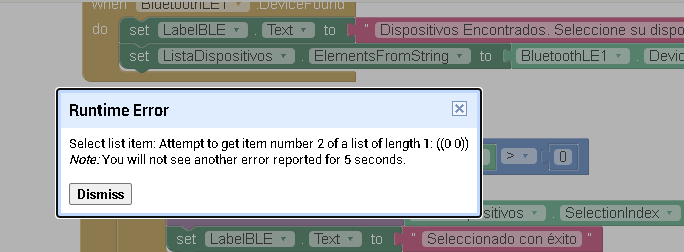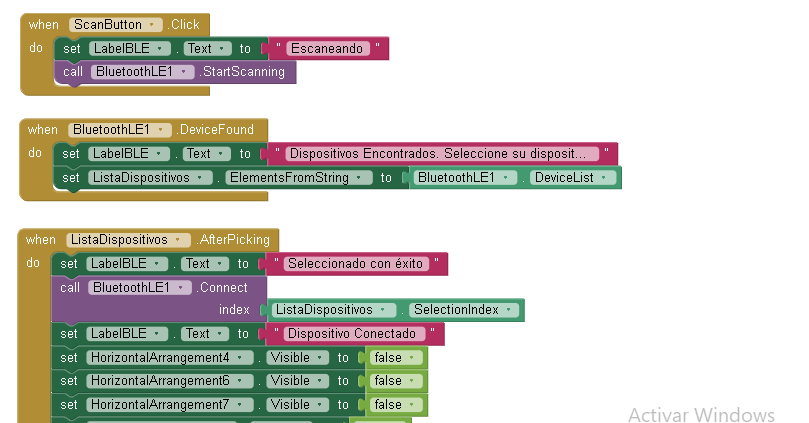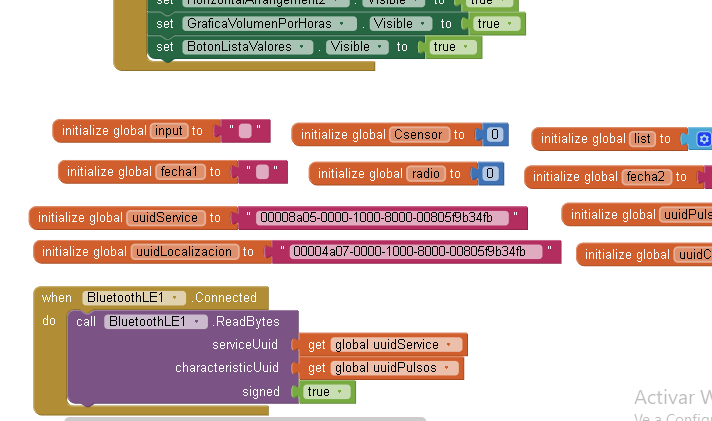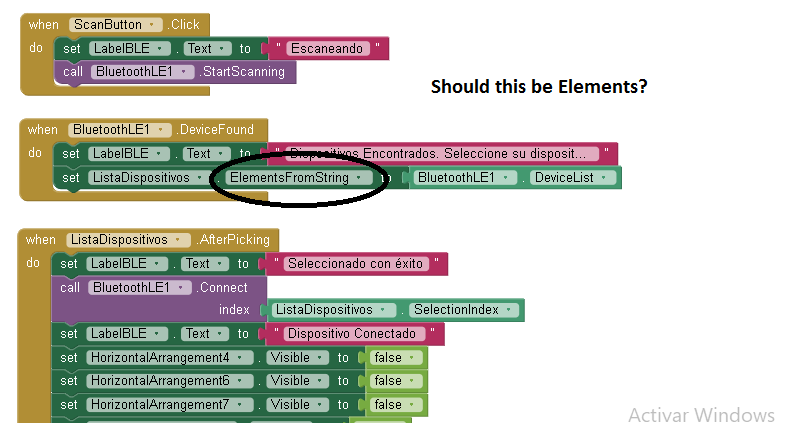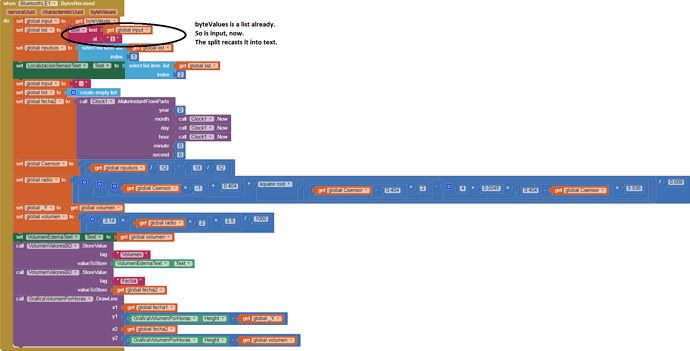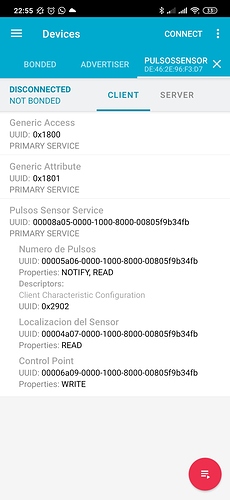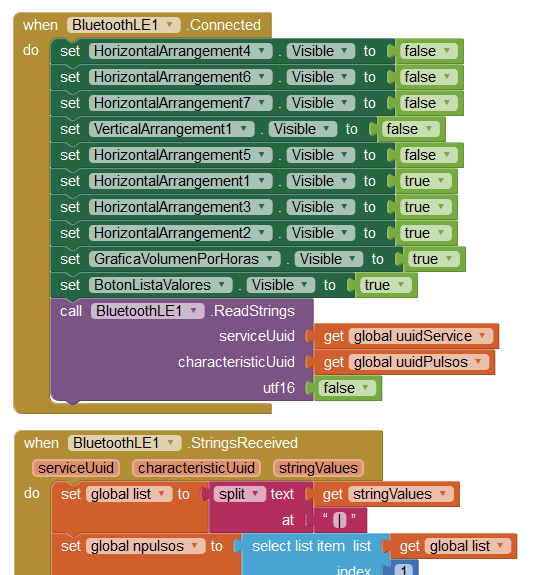I cannot upload the file cause it’s from MBED and has a “.hex” extension. @ChrisWard.
Here’s a copy from my Service class:
#ifndef BLE_PULSOS_SENSOR_RATE_SERVICE_H
#define BLE_PULSOS_SENSOR_RATE_SERVICE_H
#define UUID_PULSOS_SENSOR_RATE_SERVICE 0x8A05
#define UUID_PULSOS_SENSOR_RATE_MEASUREMENT_CHAR 0x5A06
#define UUID_LEG_SENSOR_LOCATION_CHAR 0x4A07
#define UUID_PULSOS_SENSOR_RATE_CONTROL_FUENTE_CHAR 0x6A09
#include “BLE.h”
class PulsosSensorRateService {
public:
/**
* enum Localización del sensor
* brief Localización del sensor en las piernas derecha o izquierda
/
enum {
LOCATION_OTHER = 0, /!< Other location. /
LOCATION_PIERNA_DERECHA, /!< Pierna Derecha. /
LOCATION_PIERNA_IZQUIERDA, /!< Pierna Izquierda. */
};
public:
/**
* brief Constructor con un valor de psrCounter (PulsosSensorRate Counter) de 8bits.
*
* param[ref] _ble
* Reference to the underlying BLE.
* param[in] psrCounter (8-bit)
* Valor inicial para psrRate (número de pulsos)
* param[in] location
* Localización del sensor
*/
PulsosSensorRateService(BLE &_ble, uint8_t psrCounter, uint8_t location, uint8_t controlFuente) :
ble(_ble),
valueBytes(psrCounter),
psrRate(UUID_PULSOS_SENSOR_RATE_MEASUREMENT_CHAR, valueBytes.getPointer(),
valueBytes.getNumValueBytes(), PulsosSensorRateValueBytes::MAX_VALUE_BYTES,
GattCharacteristic::BLE_GATT_CHAR_PROPERTIES_READ | GattCharacteristic::BLE_GATT_CHAR_PROPERTIES_NOTIFY),
psrLocation(UUID_LEG_SENSOR_LOCATION_CHAR, &location),
controlPoint(UUID_PULSOS_SENSOR_RATE_CONTROL_FUENTE_CHAR, &controlFuente) {
setupService();
}
PulsosSensorRateService(BLE &_ble, uint16_t psrCounter, uint8_t location,uint8_t controlFuente) :
ble(_ble),
valueBytes(psrCounter),
psrRate(UUID_PULSOS_SENSOR_RATE_MEASUREMENT_CHAR, valueBytes.getPointer(),
valueBytes.getNumValueBytes(), PulsosSensorRateValueBytes::MAX_VALUE_BYTES,
GattCharacteristic::BLE_GATT_CHAR_PROPERTIES_NOTIFY),
psrLocation(UUID_LEG_SENSOR_LOCATION_CHAR, &location),
controlPoint(UUID_PULSOS_SENSOR_RATE_CONTROL_FUENTE_CHAR, &controlFuente) {
setupService();
}
/**
* brief Establece un nuevo valor de 8 bits para los pulsos del sensor.
*
* param[in] psrCounter
* Número de pulsos.
*/
void updatePulsosSensorRate(uint8_t psrCounter) {
valueBytes.updatePulsosSensorRate(psrCounter);
ble.gattServer().write(psrRate.getValueHandle(), valueBytes.getPointer(), valueBytes.getNumValueBytes());
}
/**
* Establece un nuevo valor de 16 bit para el número de pulsos.
*
* param[in] psrCounter
* Número de pulsos.
*/
void updatePulsosSensorRate(uint16_t psrCounter) {
valueBytes.updatePulsosSensorRate(psrCounter);
ble.gattServer().write(psrRate.getValueHandle(), valueBytes.getPointer(), valueBytes.getNumValueBytes());
}
/** Devuelve el valor del atributo Gatt controlPoint*/
GattAttribute::Handle_t getValueHandle() const
{
return controlPoint.getValueHandle();
}
/**
* Esta callback permite al pulsos sensor rate service recibir actualizacion de controlPoint.
* param[in] params
* Información de la característica actualizada
*/
virtual void onDataWritten(const GattWriteCallbackParams *params) {
if (params->handle == controlPoint.getValueAttribute().getHandle()) {
}
}
protected:
void setupService(void) {
GattCharacteristic *charTable[] = {&psrRate, &psrLocation, &controlPoint};
GattService psrService(UUID_PULSOS_SENSOR_RATE_SERVICE, charTable, sizeof(charTable) / sizeof(GattCharacteristic *));
ble.addService(psrService);
ble.onDataWritten(this, &PulsosSensorRateService::onDataWritten);
}
protected:
/Representación privada interna de los bytes que trabajan con el valor de la característica numero de pulsos rate/
struct PulsosSensorRateValueBytes {
static const unsigned MAX_VALUE_BYTES = 5; /* Flags, and up to two bytes for heart rate. */
static const unsigned FLAGS_BYTE_INDEX = 0;
static const unsigned VALUE_FORMAT_BITNUM = 0;
static const uint8_t VALUE_FORMAT_FLAG = (1 << VALUE_FORMAT_BITNUM);
PulsosSensorRateValueBytes(uint8_t psrCounter) : valueBytes() {
updatePulsosSensorRate(psrCounter);
}
PulsosSensorRateValueBytes(uint16_t psrCounter) : valueBytes() {
updatePulsosSensorRate(psrCounter);
}
void updatePulsosSensorRate(uint8_t psrCounter) {
valueBytes[FLAGS_BYTE_INDEX] &= ~VALUE_FORMAT_FLAG;
valueBytes[FLAGS_BYTE_INDEX + 1] = psrCounter;
}
void updatePulsosSensorRate(uint16_t psrCounter) {
valueBytes[FLAGS_BYTE_INDEX] |= VALUE_FORMAT_FLAG;
valueBytes[FLAGS_BYTE_INDEX + 1] = (uint8_t)(psrCounter & 0xFF);
valueBytes[FLAGS_BYTE_INDEX + 2] = (uint8_t)(psrCounter >> 8);
}
uint8_t *getPointer(void) {
return valueBytes;
}
const uint8_t *getPointer(void) const {
return valueBytes;
}
unsigned getNumValueBytes(void) const {
return 1 + ((valueBytes[FLAGS_BYTE_INDEX] & VALUE_FORMAT_FLAG) ? sizeof(uint16_t) : sizeof(uint8_t));
}
private:
/* Primer byte: 8-bit values, no extra info. Segundo byte: uint8_t PSR value */
uint8_t valueBytes[MAX_VALUE_BYTES];
};
protected:
BLE &ble;
PulsosSensorRateValueBytes valueBytes;
GattCharacteristic psrRate;
ReadOnlyGattCharacteristic<uint8_t> psrLocation;
WriteOnlyGattCharacteristic<uint8_t> controlPoint;
};
#endif /* #ifndef BLE_PULSOS_SENSOR_RATE_SERVICE_H*/
